

Photo by Mark Olsen on Unsplash
1. Indoor-air quality is a key element of wellness architecture, so choose your finishing options carefully. Opt for paint and stain finishes that have low VOCs, manmade countertop materials (think quartz or concrete) that are less porous and, therefore, less likely to cultivate bacteria and flooring products, such as bamboo, that are highly sustainable and don’t result in off-gassing, suggests designer Michael Grant.
2. For mind-body balance, keep purpose in the forefront during design, especially when it comes to integral spaces like the kitchen. “The kitchen has evolved to support healthier zones for food prep, cooking, baking, organization and eating. It also reinforces the social aspect of food and how it supports interaction with family and friends, as well as improves our emotions,” says Michael.
3. Create a spa-like bathroom that can be a retreat for relaxation and renewal, with the inclusion of luxuries like a steam shower, a jetted spa tub or a wet room. These perceived “indulgences” actually foster a sense of mental well-being, which, in turn, is essential to physical health.











